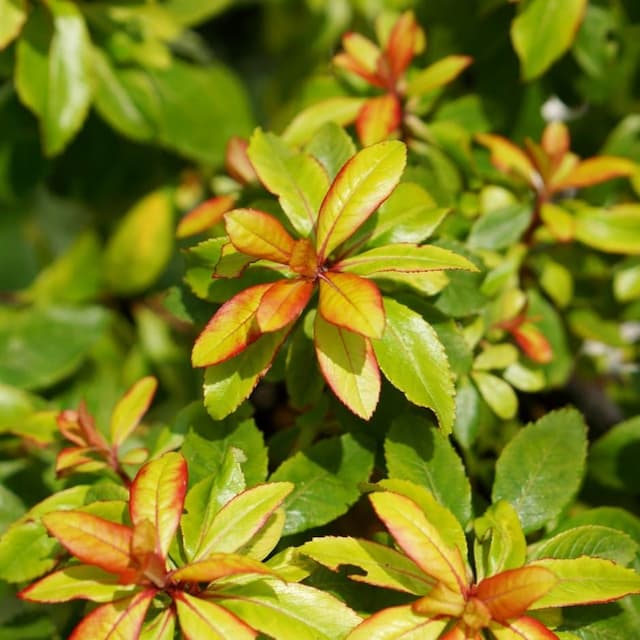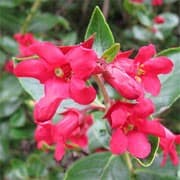Escallonia Escallonia 'Donard Seedling'

ABOUT
Escallonia 'Donard Seedling' is an attractive evergreen shrub known for its glossy, dark green leaves, which provide a lush backdrop to its blossoms. The leaves are small, neat, and have a slight serration along the edges, adding texture to the plant's appearance. It produces clusters of small, bell-shaped flowers that range in color from a delicate pale pink to a more vivid rose-pink, with a subtle fragrance. These flowers provide a striking contrast against the foliage and are a favorite with pollinators such as bees and butterflies. The overall shape of the plant is bushy and dense, with a tendency to spread, creating a full and rounded appearance that is pleasing to the eye. It can be a significant feature in a garden, offering year-round interest thanks to its evergreen nature and prolonged flowering season.
About this plant
 Names
NamesFamily
Escalloniaceae
Synonyms
Donard Seedling Escallonia, Donard Beauty
Common names
Escallonia 'Donard Seedling'.
 Toxicity
ToxicityTo humans
Escallonia 'Donard Seedling', commonly known as Escallonia, is not commonly listed as a toxic plant to humans. There is limited information available on the toxicity levels of this specific cultivar to humans, and it does not generally appear on lists of poisonous plants. However, as with any plant, it is advisable to exercise caution and avoid ingestion. If parts of the plant are ingested and symptoms of poisoning appear, it is important to seek medical attention. It's also worth noting that individual sensitivities can vary, so some people might experience adverse reactions when handling or ingesting plants that are not typically known to be toxic.
To pets
Escallonia, the common name for Escallonia 'Donard Seedling', is not widely known to be toxic to pets. Information about the toxicity of this specific cultivar to animals is not extensively documented, meaning it does not have a prominent reputation as a poisonous plant to household pets like cats and dogs. However, the general rule of thumb with pets is to prevent them from eating plants that haven't been confirmed as safe. If your pet does consume parts of the Escallonia and then displays signs of poisoning, such as vomiting, diarrhea, or lethargy, you should seek immediate veterinary care. Always be cautious and consult with a veterinarian if you are uncertain about the safety of plants in your garden regarding your pets' health.
 Characteristics
CharacteristicsLife cycle
Perennials
Foliage type
Evergreen
Color of leaves
Green
Flower color
Pink
Height
4-6 feet (1.2-1.8 meters)
Spread
4-6 feet (1.2-1.8 meters)
Plant type
Shrub
Hardiness zones
7
Native area
South America
Benefits
 General Benefits
General Benefits- Attractive Flowers: Escallonia 'Donard Seedling' produces clusters of pink, tubular flowers that can add a splash of color to gardens.
- Dense Foliage: The plant has dense, glossy green leaves that create a lush backdrop and can provide privacy as a hedge or screen.
- Drought Tolerance: Once established, it can tolerate periods of drought, making it suitable for gardens in dryer climates.
- Coastal Suitability: It can withstand maritime exposure and is a good choice for coastal gardens subject to salty winds.
- Low Maintenance: Escallonia 'Donard Seedling' requires minimal care, making it an easy plant to grow for gardeners of all skill levels.
- Pollinator Friendly: The flowers are attractive to bees and other pollinators, supporting biodiversity in the garden.
- Versatile Planting: It can be planted as a singular specimen, as part of a shrub border, or used for hedging and screening.
- Year-Round Interest: With evergreen foliage, it offers visual interest throughout all seasons, providing a constant feature in the garden landscape.
- Fast Growing: It has a relatively quick growth rate, which can be advantageous for gardeners wanting to establish a hedge or fill in a space rapidly.
- Wind Resistance: Its sturdy nature makes it a good windbreak, particularly in exposed or coastal gardens.
 Medical Properties
Medical PropertiesThis plant is not used for medical purposes.
 Air-purifying Qualities
Air-purifying QualitiesThis plant is not specifically known for air purifying qualities.
 Other Uses
Other Uses- Windbreak: Escallonia can be planted as a dense hedge, which serves as a windbreak to protect more delicate plants in the garden.
- Topiary: Due to its dense growth habit, the Escallonia can be trimmed into various shapes for topiary designs.
- Erosion Control: The plant is ideal for planting on slopes or areas prone to erosion to help stabilize the soil.
- Bee Attraction: Escallonia flowers are rich in nectar, making them an excellent choice for attracting bees and benefiting local pollination.
- Privacy Screening: The thick foliage of Escallonia can be used to create a privacy screen in residential areas or gardens.
- Coastal Gardening: Suitable for coastal regions, Escallonia can withstand salt sprays and is used in seaside planting schemes.
- Noise Reduction: When planted in mass, the Escallonia hedge can help reduce noise pollution from roads and industrial areas.
- Bonsai: With proper pruning, Escallonia can be cultivated as a bonsai plant, offering a unique hobby for enthusiasts.
- Urban Landscaping: Escallonia is robust enough to be used in urban settings, contributing greenery and aesthetic appeal to city landscapes.
- Wildlife Shelter: The dense growing pattern of the shrub provides an excellent shelter for small birds and beneficial insects.
Interesting Facts
 Feng Shui
Feng ShuiEscallonia is not used in Feng Shui practice.
 Zodiac Sign Compitability
Zodiac Sign CompitabilityEscallonia is not used in astrology practice.
 Plant Symbolism
Plant Symbolism- Resilience: Escallonia 'Donard Seedling', known for its hardy nature, is often associated with resilience, representing the ability to endure challenging conditions and recover from adversity.
- Protection: With its evergreen foliage and dense growth habit, Escallonia serves as a symbol of protection, offering shelter and a safe haven for birds and beneficial insects.
- Beauty: The attractive flowers of the Escallonia, which bloom in shades of pink, red, or white, symbolize beauty and grace, reflecting the aesthetic pleasure these plants bring to a garden.
- Boundary: Oftentimes used as a hedging plant, Escallonia can symbolize the setting of boundaries or the demarcation of personal space, representing the importance of respecting one's private life or property.
 Water
WaterEscallonia 'Donard Seedling', commonly known as Escallonia, should be watered deeply to encourage a strong root system, usually once a week during its growing season. The soil should be allowed to dry out slightly between waterings. A general guideline is to provide about 1 to 1.5 gallons of water per week, depending on the weather conditions and soil type. During hot, dry periods, water may be needed more frequently, while in cooler, wetter conditions, less water may be required. It is important not to overwater as this can lead to root rot.
 Light
LightEscallonia prefers a location with full sun to partial shade. The best spot for Escallonia would be a location where it receives at least 6 hours of direct sunlight daily, although it can tolerate some light shade. Avoid deep shade as this can result in fewer flowers and a leggy growth habit.
 Temperature
TemperatureEscallonia thrives in moderate temperatures, ideally between 50°F to 75°F. It can withstand minimum temperatures down to about 15°F and maximum temperatures as high as 95°F. It is important to protect the plant from extreme cold by providing shelter or applying mulch around the base during the winter months.
 Pruning
PruningEscallonia should be pruned to maintain shape, remove dead or damaged branches, and promote vigorous growth. The best time to prune is in late winter or early spring before new growth starts. Light pruning can be done throughout the year as needed to remove broken or diseased branches. Generally, pruning once a year is sufficient for healthy growth.
 Cleaning
CleaningNot needed
 Soil
SoilThe Escallonia prefers a well-draining soil mix with a slightly acidic to neutral pH of about 5.5 to 7. Incorporating organic matter like compost or peat into a base of loamy soil can provide an ideal environment for the plant's growth.
 Repotting
RepottingThe Escallonia, typically grown as a shrub outdoors, does not require frequent repotting. However, if grown in containers, consider repotting every 2 to 3 years to refresh the soil and allow for root growth.
 Humidity & Misting
Humidity & MistingEscallonia plants are quite adaptable but prefer moderate humidity levels; they do not require high humidity to thrive.
 Suitable locations
Suitable locationsIndoor
Provide bright, indirect light and ensure good air circulation.
Outdoor
Plant in well-drained soil with full sun to partial shade.
Hardiness zone
7-9 USDA
 Life cycle
Life cycleThe life cycle of the Escallonia 'Donard Seedling', commonly known as Donard Seedling Escallonia, begins with the germination of seeds in the appropriate soil and environmental conditions. Seedlings emerge and gradually establish a root system and foliage through the juvenile phase, which is characterized by rapid vegetative growth. The plant then enters the mature phase, where it develops woody stems and a more robust structure, while continuing to produce dense, glossy green leaves. During the reproductive stage, typically in the summer, Donard Seedling Escallonia produces clusters of small, tubular pink to white flowers that are attractive to pollinators. After pollination, the flowers develop into small capsules containing seeds that will disperse and have the potential to germinate, thus continuing the cycle. The plant's life span encompasses several years, as it is a hardy evergreen shrub that can endure various seasons and continue to grow and reproduce as long as conditions are favorable.
 Propogation
PropogationPropogation time
Spring-Early Summer
Escallonia 'Donard Seedling', commonly known as Donard Seedling Escallonia, is typically propagated by semi-hardwood cuttings. The optimal time for taking these cuttings is in late summer to early autumn when the current season's growth has started to mature. The process involves selecting a healthy stem with several leaves, cutting it at a length of 4 to 6 inches (about 10 to 15 centimeters) and removing the lower leaves to create a bare stem. The cutting end is then dipped in rooting hormone powder to encourage root growth and planted in a pot filled with a mixture of peat and perlite for good drainage. The cutting should be kept in a warm, humid environment, out of direct sunlight, to promote rooting. With proper care, the cutting will develop roots within a few weeks, after which it can be transplanted to a larger pot or into the garden.




